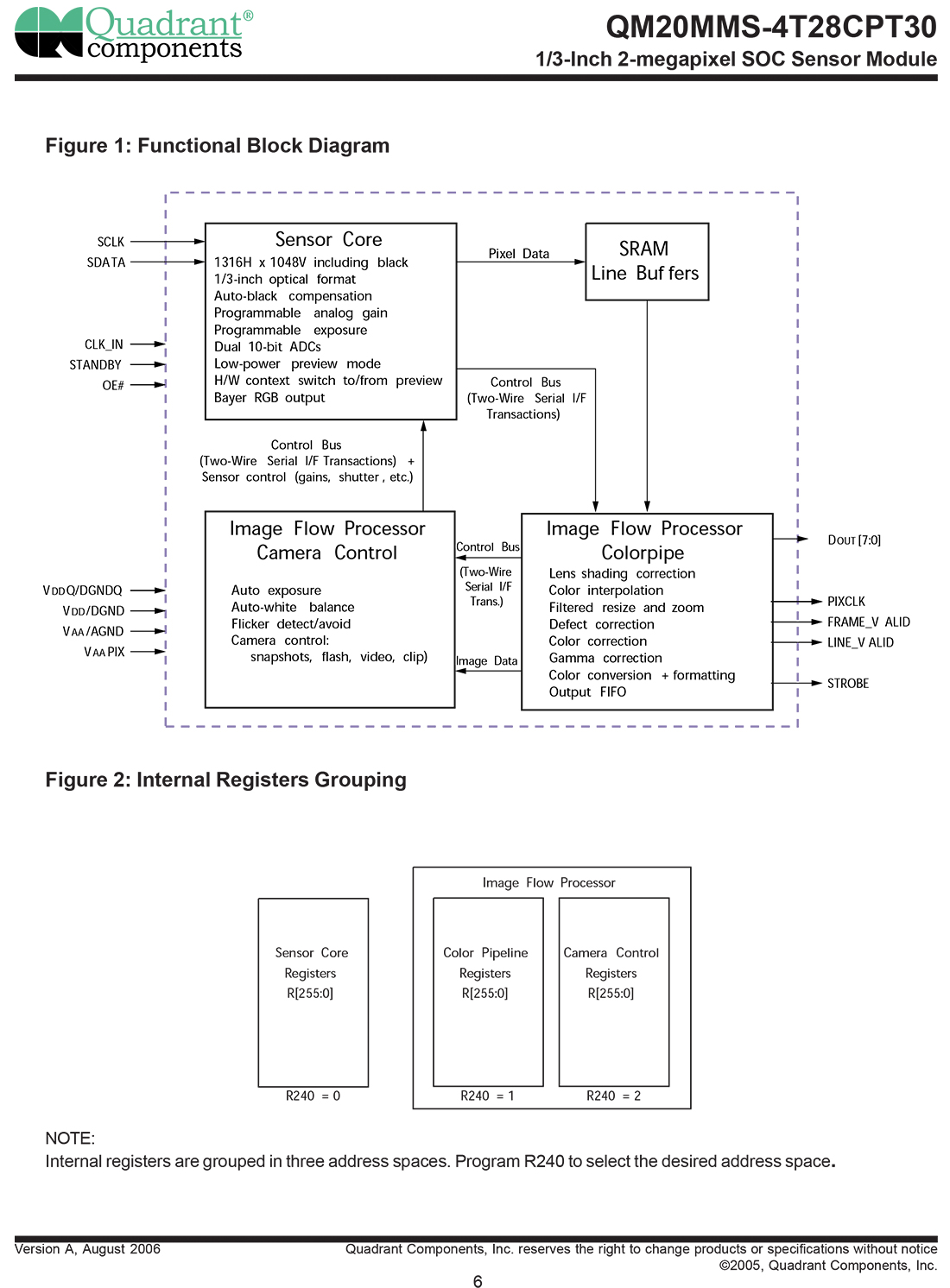MT9D111,Mi-2010,QM20MMS-4T28CPT30美光200万像素美国扩展QUADRANT COMPONENTS PLCC28封装工业相机图像传感器2MP CMOS SENSOR1600x1200,1/3-Inch 2-megapixel SoC片上系统Sensor Module
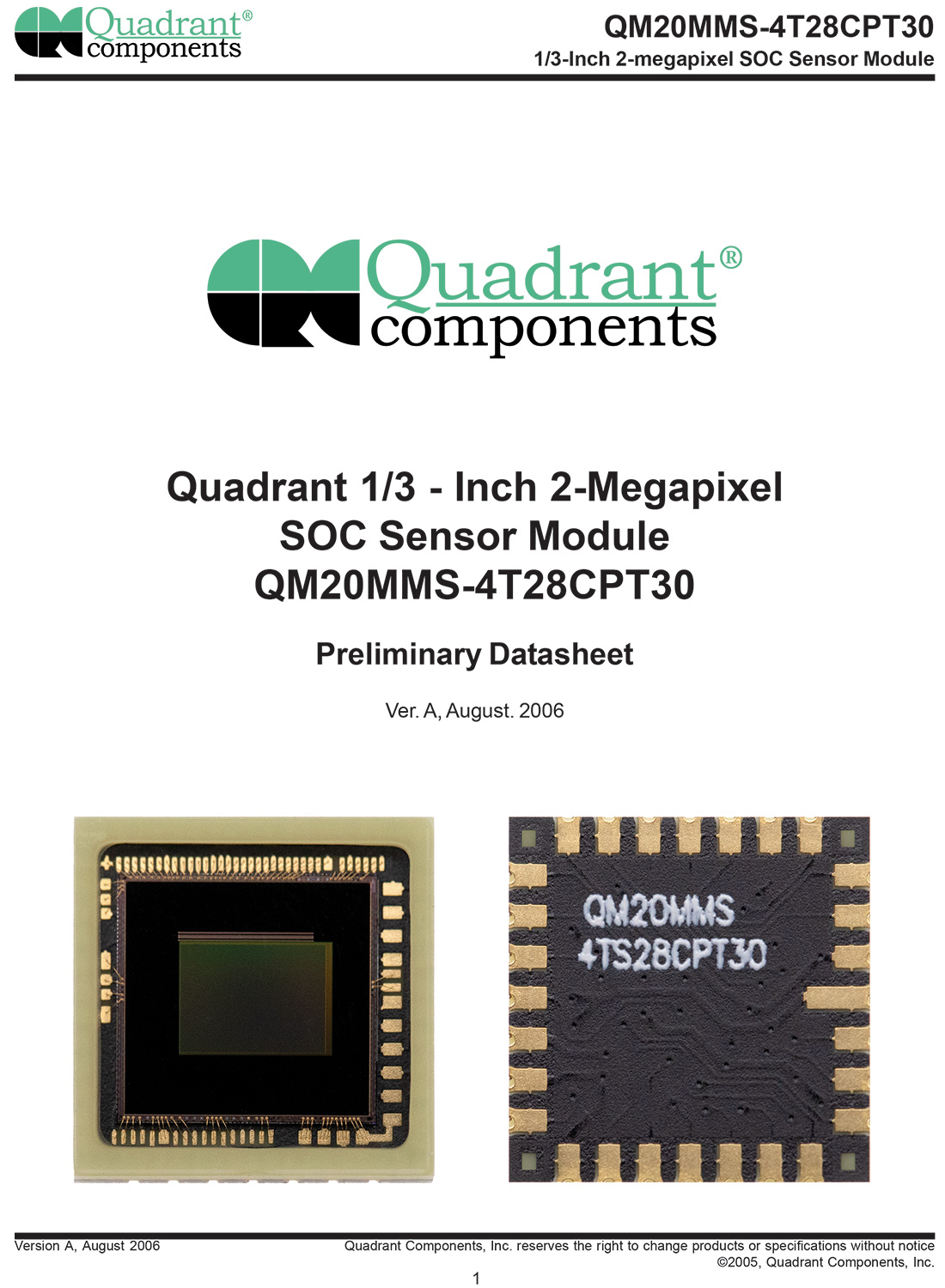
1. Features
※ DigitalClarity TM CMOS Imaging Technology System-On-Chip (SOC)-Completely integrated camera system Ultralow power, lowcost, progressive scan CMOS image sensor Superior low-light performance On-chip image flow processor (IFP) performs sophisticated processing:
※ Color recovery and correction
※ Sharpening, gamma, lens-shading correction
※ On-the-fly defect correction
※ Filtered image downscaling to arbitrary size with smooth, continuous zoom and pan
Automatic Features:
※ Auto exposure (AE)
※ Auto white balance (AWB)
※ Auto black reference (ABR)
※ Auto flicker avoidance
※ Auto color saturation
※ Auto defect identification and correction
※ Fully auto matic Xenon and LED-type flash support
※ Fast exposure adaptation
※ Multiple parameter contexts
※ Easy / fast mode switching
※ Camera control sequencer automates
※ Snapshots
※ Snapshots with flash Video clips
※ Simple two-wire serial programming interface
※ ITU-R BT.656 ( YCbCr) , 565RGB, 555RGB or 444RGB
※ formats (progressive scan)
※ Raw and processed Bayer formats
※ Output FIFO and integer clock divider:“Uniform” pixel clocking
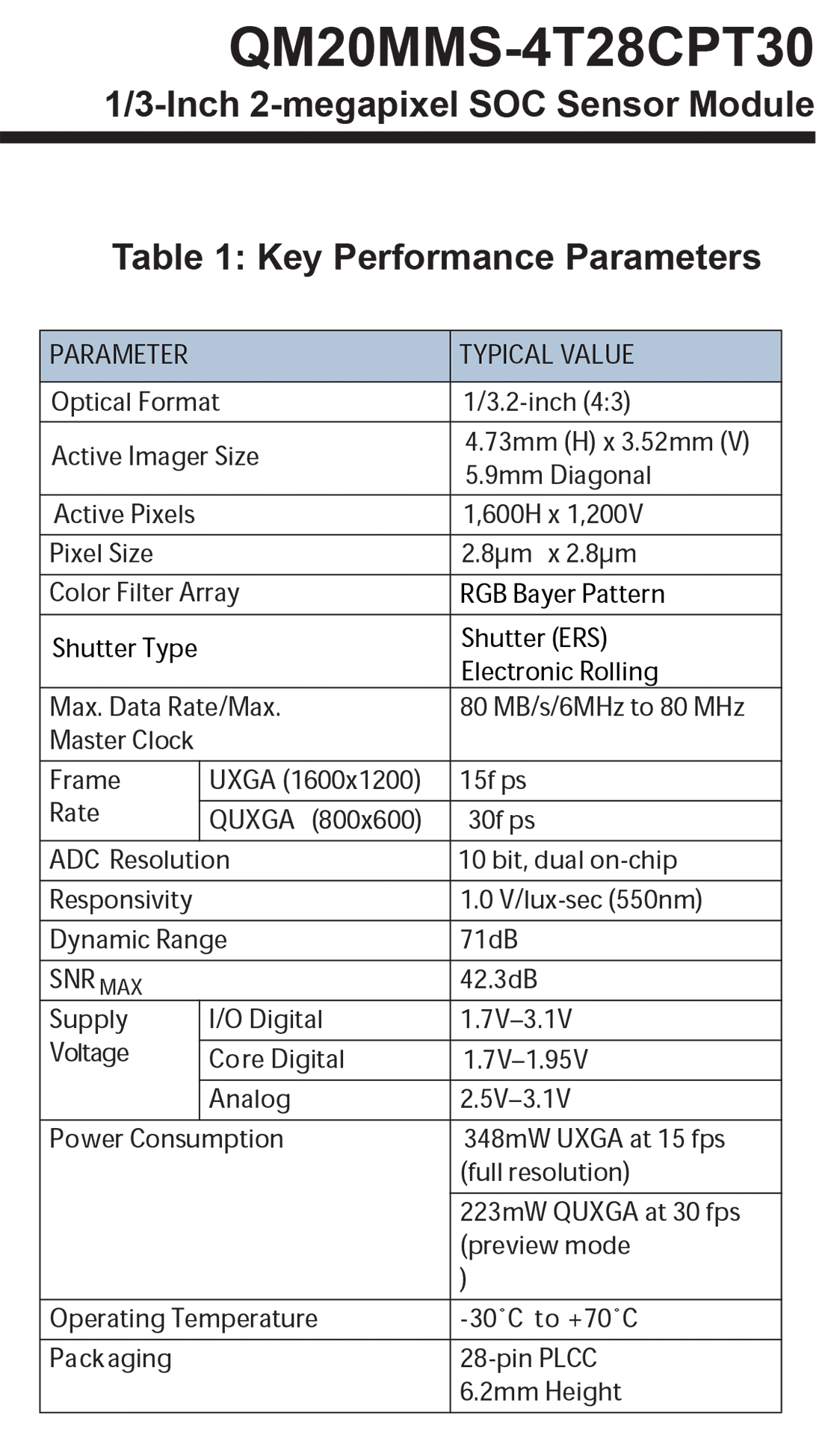
2. Applications:
※ Cellular phones
※ PDAs
※ Toys
※ Other battery-powered products
※ Industrial camera
3. General Description
The Quadrant Imaging QM20MMS-4TS28CPT30 is an SXGA-format single-chip camera with a one-third-inch CMOS activepixel digital image sensor . This device combines the QM13MMS image sensor core with fourth-generation digital-imageflow processor technology from Imaging. It captures high quality color images at SXGA resolution.
This megapixel CMOS image sensor features DigitalClarity—a Quadrant breakthrough—low-noise CMOS imaging technology. This technology achieves CCD image quality (based on signal-to-noise ratio and lowlight sensitivity) while maintaining the inherent size, cost, and integration advantages of CMOS.
The sensor is a complete camera-on-a-chip solution designed specifically to meet the low-power, lowcost demands of battery-powered products such as cellular phones , PDA s, and toys. It incorporates sophisticated camera functions onchip and is programmable through a simple two-wire serial interface.
The QM20MMS-4TS28CPT30 performs sophisticated processing functions including color recovery, color correction, sharpening, programmable gamma correction, auto black reference claming, auto exposure (AE), automatic 50Hz/60Hz flicker avoidance, lens-shading correction, auto white balance (AWB), and on-the-fly defect identification and correction.
Additional features
include day/night mode configurtions; special camera effects such as sepiatone and solarization; and interpolation to arbitrary image size with continuous filtered zoom and pan. The device supports both Xenon and LED-type flash light sources in several snapshot modes.
The QM20MMS-4TS28CPT30 can be programmed to output progressive- scan images up to 30 frames per second (fps); in preview power -saving mode, and 15fps in full-resolution (SXGA) mode. In either mode, the image data can be output in any one of six 8-bit formats:
※ ITU-R BT.656 (formerly CCIR 656, progressive scan only) YCbCr
※ 565RGB
※ 555RGB
※ 444RGB
※ Raw Bayer
“ Processed” Bayer
The FR AME_VALID and LI NE_ VALID signals are output on dedicated pins, along with a pixel clock that is synchronous with valid data.
4. Feature Overview
The Quadrant is a fully-automatic, single-chip camera, requiring only a power supply, lens and clock source for bas coperation. Output video is streamed via a parallel eight-bit DOUT port as shown in Figure 1 on page 6. The output pixel clockis used to latch data, while FRAME_V ALID and LINE_V ALID signals indicate the active video. The QM20MMS-4TS28CPT30 in ternal registers are configured using a two-wire serial interface.
The device can be put in an low-power sleep mode by asserting the standby pin and shutting down the clock. Output pads can be tri-stated by de-asserting the OE# pin. Both tri-stating output pins and entry into standby mode can also be achieved via two-wire serial interface register writes.
The QM20MMS-4TS28CPT30 accepts input clocks up to 54MHz, delivering up to 15fps for UXGA resolution images, and up to 30fps for QUXGA (full field-of-view, sensor pixel skipping) images. The device also includes a lowpower preview configuration that delivers UXGA images at 7.5fps, and QUXGA images at 30fps. The device can be programmed to slow the frame rate in low-light conditions to achieve longer exposures and better image quality. Standard FRAME_VALID / LINE_ VALID video.
Internal Architecture
Internally, consists of a sensor core and an image-flow processor (IFP). The IFP is divided into two sections: the colorpipe (CP), and the camera controller (CC). The sensor core captures raw Bayer- encoded images that are then input in to the IFP. The CP section of the IFP processes the incoming stream to create interpolated, color-corrected output, and the CC section controls the sensor core to mainta in the desired exposure and color balance, and to support snapshot modes. The sensor core, CP, and CC registers are grouped into three separate address spaces as shown in Figure 2. When accessing internal registers via the two-wire serial interface, select the desired address space by programming the R240 shared register.
The QM20MMS-4TS28CPT30 accelerates mode-switching with hardware-assisted context switching, and supports taking snapshots, flash snapshots, and video clip s using a configurable sequencer.
The QM20MMS-4TS28CPT30 supports a range of color formats derived from four primary color representations:
YCbCr, RGB, raw Bayer (unprocessed, directly from the sensor) and processed Bayer ( ayer- format data regener ated from processed RGB). The device also supports a variety of output signaling/ timing options :
Standard FRAME_VALID / LINE_ VALID video interface with gated pixel clocks
Standard video interface with uniform clocking ITU-R BT.656 marker-embedded video interface with either gated or uniform
pixel clocking.
Register Notation
The following register address notations are used in this document:
※ R:
※ Example: R9:0—S hutter width register in sensor
※ page (page 0). Used to uniquely specify a register.
※ R
※ Example: R240—Page address register. Used when the register address is the same in all three pages or when by context the address page is understood.
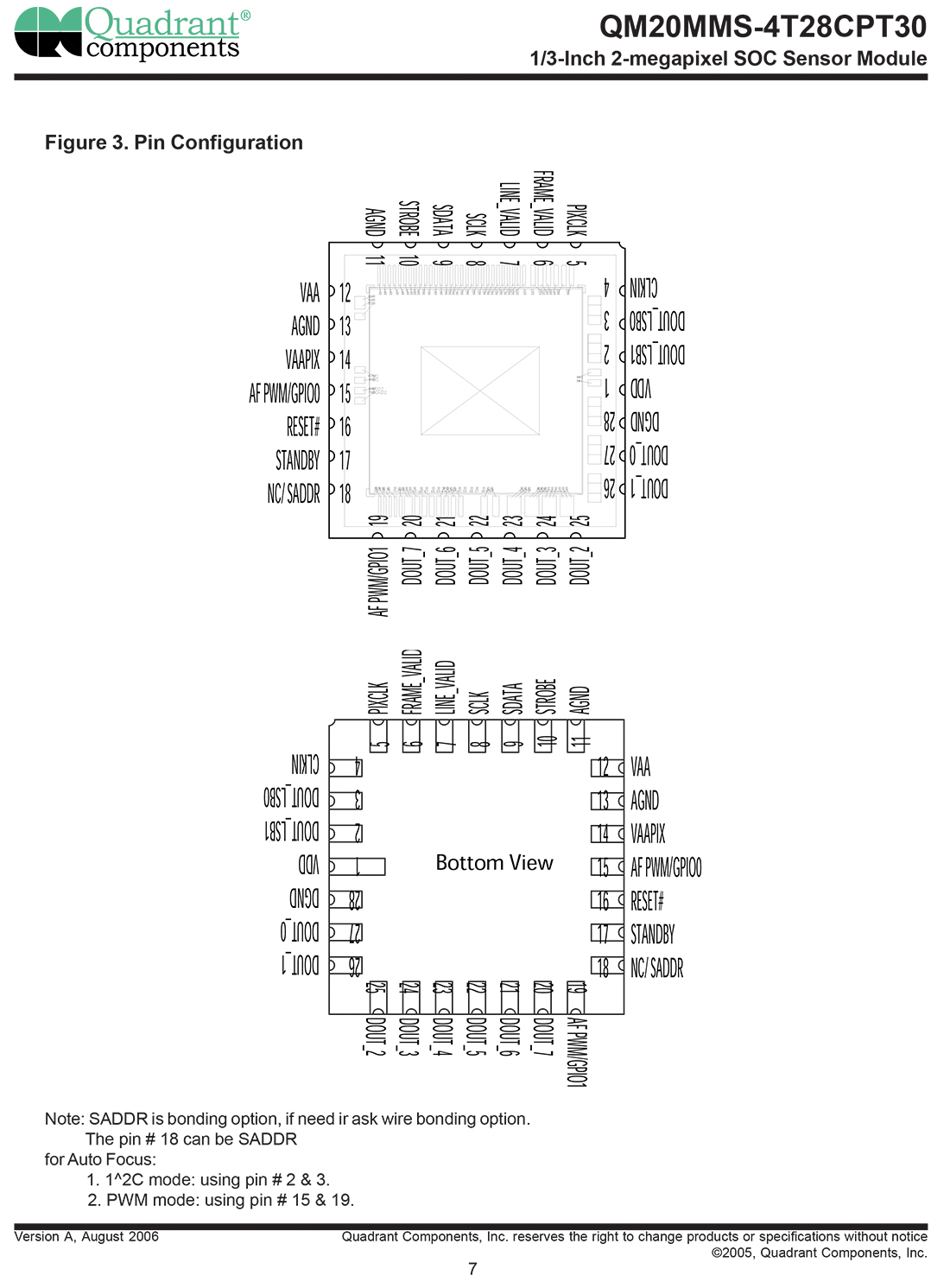
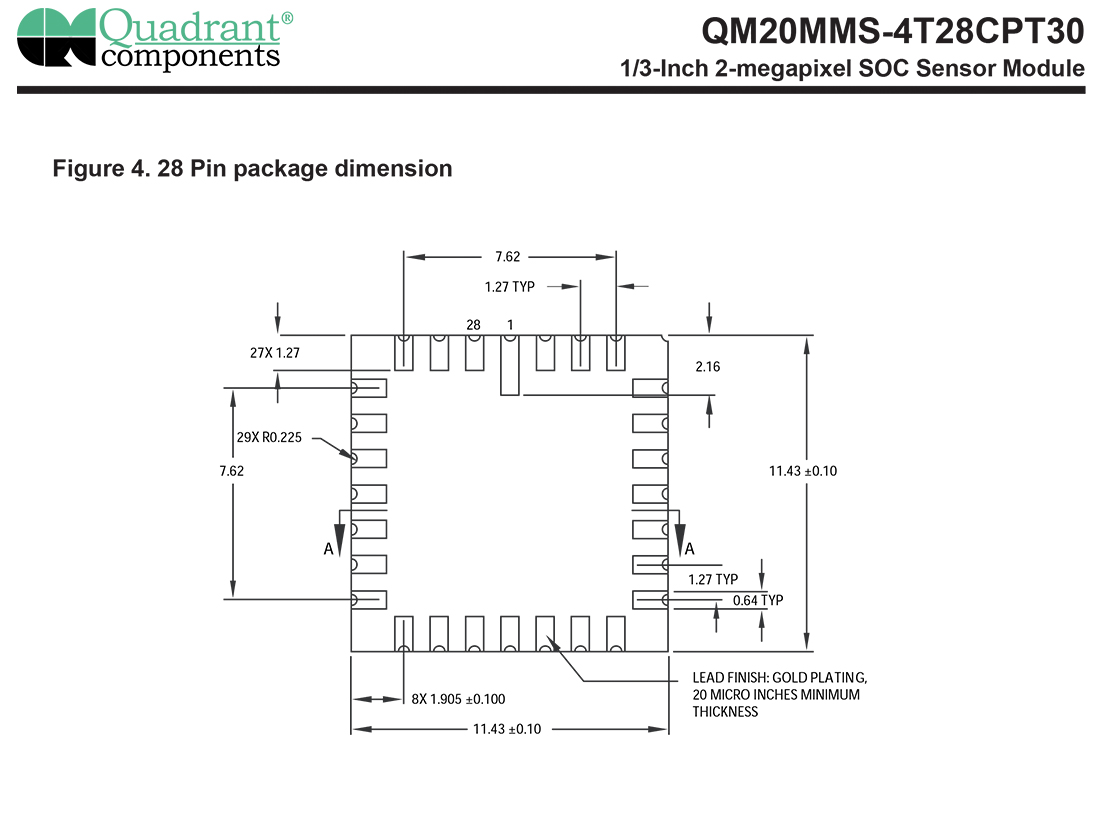
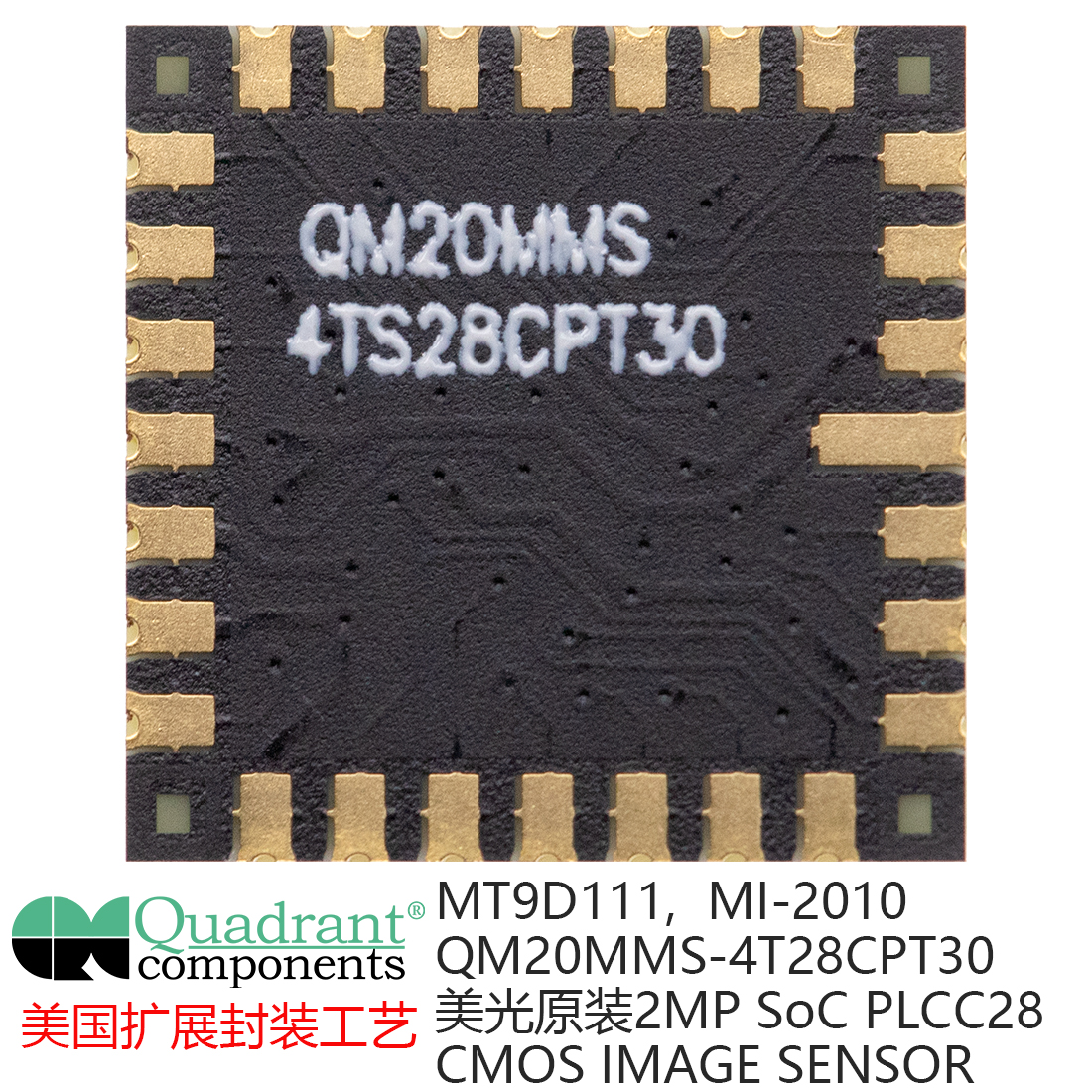
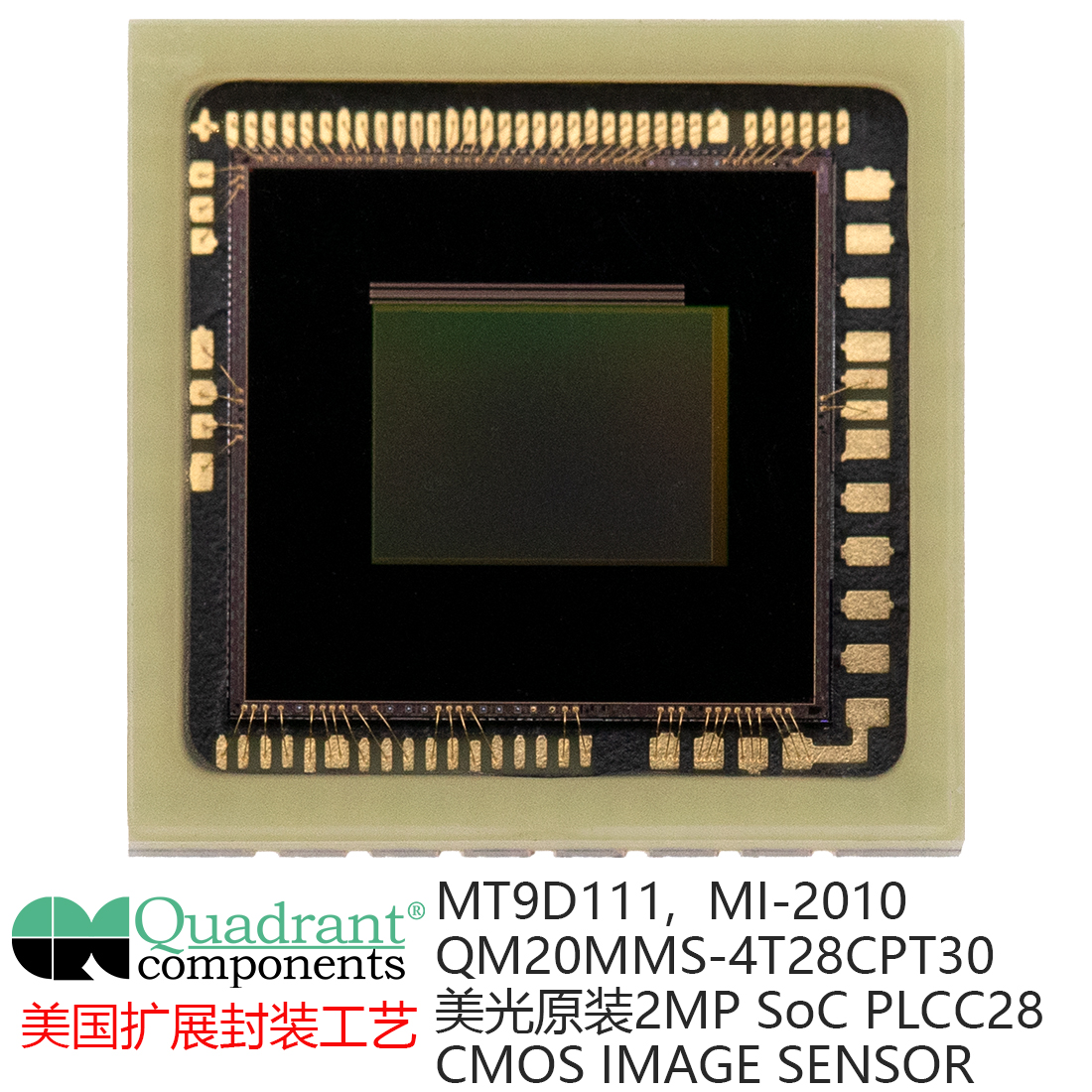
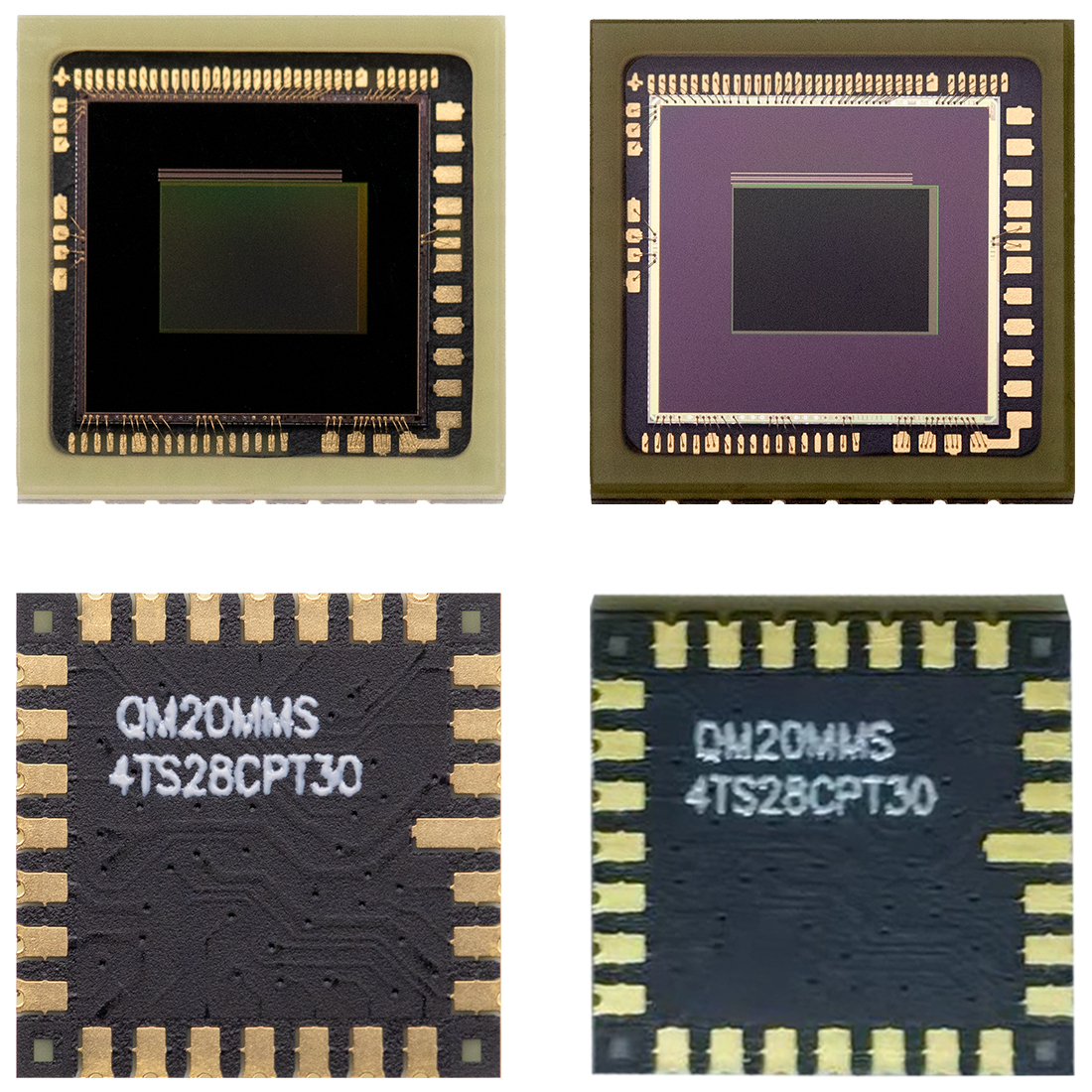
1. 特性
※ DigitalClarity TM CMOS成像技术系统片上(SOC)-完全集成的摄像机系统超低功耗,低成本,渐进扫描CMOS图像传感器优越的微光性能片上图像流处理器(IFP)执行复杂的处理:
※ 颜色恢复和校正
※ 锐化、伽玛、镜头阴影校正
※ 实时缺陷校正
※ 过滤图像降尺度到任意大小,平滑,连续缩放和平移
自动特点:
※ 自动曝光(AE)
※ 自动白平衡
※ 自动黑参考(ABR)
※ 自动避免闪烁
※ 自动色彩饱和度
※ 自动缺陷识别和修正
※ 全自动氙气和led闪光灯支持
※ 快速曝光适应
※ 多个参数上下文
※ 模式切换方便快捷
※ 摄像头控制顺序自动完成
※ 快照、
※ 快照与flash视频剪辑
※ 简单的二线串行编程接口
※ ITU-R BT.656 (YCbCr), 565RGB, 555RGB或444RGB
※ 格式(逐行扫描)
※ 未经加工的拜耳格式
※ 输出FIFO和整数时钟分频器:“均匀”像素时钟
2. 应用:
※ 手机、
※ pda、
※ 玩具、
※ 其他电池驱动产品
※ 工业相机
3.一般的描述
象限成像QM20MMS-4TS28CPT30是一款SXGA格式的单芯片相机,带有1 / 3英寸CMOS有源像素数字图像传感器。该设备结合了QM13MMS图像传感器核心与成像的第四代数字图像流处理器技术。它捕捉高质量的彩色图像在SXGA分辨率。
这一百万像素CMOS图像传感器具有DigitalClarity -是一种象限突破低噪声CMOS成像技术。该技术在保持CMOS固有尺寸、成本和集成优势的同时,实现了CCD图像质量(基于信噪比和低光敏度)。
传感器是一个完整的芯片上的摄像头解决方案,专为满足低功率,低成本的电池供电产品,如手机,PDA和玩具的需求。它在芯片上集成了复杂的相机功能,并通过简单的两线串行接口进行编程。
QM20MMS-4TS28CPT30执行复杂的处理功能,包括色彩恢复,色彩校正,锐化,可编程伽马校正,自动黑参考校正,自动曝光(AE),自动50Hz/60Hz闪烁避免,镜头遮光校正,自动白平衡(AWB),以及实时缺陷识别和校正。
附加功能
包括昼/夜模式配置;特殊的相机效果,如海蚀和日化;和插值
任意图像大小与连续过滤缩放和平移。该设备支持氙气和led型闪光灯酸多个快照模式下的源。
QM20MMS-4TS28CPT30可编程输出渐进扫描图像,最高每秒30帧(fps);在预览省电模式,和15fps全分辨率(SXGA)模式。在任何一种模式下,图像数据可以以六种8位格式中的任何一种输出:
※ ITU-R BT.656(原CCIR 656,仅渐进扫描)YCbCr
※ 565RGB
※ 555RGB
※ 444RGB
※ RAW BAYER
※ “加工”拜耳
FR AME_VALID和LI NE_ VALID信号在专用引脚上输出,以及一个同步的像素时钟有效数据。
4. 功能概述
象限相机是一款全自动单片相机,只需要一个电源、镜头和时钟源就可以实现基本的协作。输出视频通过一个并行的8位DOUT端口流,如图6页上的图1所示。输出像素时钟用于锁存数据,而FRAME_V ALID和LINE_V ALID信号表示活动视频。外部寄存器中的QM20MMS-4TS28CPT30使用两线串行接口配置。
该设备可以通过断言待机引脚和关闭时钟置于低功耗睡眠模式。输出焊盘可以通过取消OE#引脚来三态化。三态输出引脚和进入待机模式也可以通过二线串行接口寄存器写入实现。
QM20MMS-4TS28CPT30可以接受高达54MHz的输入时钟,UXGA分辨率的图像可以达到15fps, QUXGA(全视场,传感器像素跳跃)图像可以达到30fps。该设备还包括一个低功耗预览配置,以7.5帧/秒的速度提供UXGA图像,以30帧/秒的速度提供QUXGA图像。该设备可以通过编程在低光条件下减慢帧率,以实现更长的曝光时间和更好的图像质量。标准FRAME_VALID / LINE_有效视频。
内部架构
内部由一个传感器核心和一个图像流处理器(IFP)组成。IFP分为两个部分:彩色管(CP)和摄像机控制器(CC)。传感器核心捕获原始的拜耳编码图像,然后输入到IFP。IFP的CP部分处理传入流以创建插值的、颜色校正的输出,而CC部分控制传感器核心以保持所需的曝光和颜色平衡,并支持快照模式。传感器核心、CP和CC寄存器被分组为三个独立的地址空间,如图2所示。当通过二线串行接口访问内部寄存器时,通过编程R240共享寄存器选择所需的地址空间。
QM20MMS-4TS28CPT30通过硬件辅助的上下文切换加速模式切换,并支持使用可配置的音序拍摄快照、闪光快照和视频剪辑。
QM20MMS-4TS28CPT30支持一系列源自四种主要颜色表示的颜色格式:
YCbCr, RGB,原始拜耳(未处理,直接从传感器)和处理拜耳(层格式数据从处理RGB再生)。该设备还支持多种输出信令/定时选项:
标准的FRAME_VALID / line_valid视频接口,带有门控像素时钟
标准视频接口,统一时钟ITU-R BT.656标记嵌入视频接口,门控或统一像素时钟。
注册标记
本文档使用了以下寄存器地址符号:
※ R:
※ 例如:传感器中的R9:0-S hutter宽度寄存器
※ page (page 0).用于唯一地指定寄存器。
※ R
※ 例如:R240页地址寄存器。当注册地址在所有三页中相同或根据上下文时使用可以理解地址页面。
有关MT9D111,MI2010,QM20MMS-4T28CPT30格,datasheet,简介,电路图,文档下载,原装现货,现货库存,芯片,图片,规格书,代理商,技术支持,产品介绍,参数,方案商,分销商,经销商,官网,生产厂家,专卖店,高价收购,模组,模块,特价,库存,生产商,哪里买,性价比,用途,封装厂,晶圆厂,代工厂,可咨询本公司
If you want to know more about the package details of this part number, please click the corresponding blue area above.


